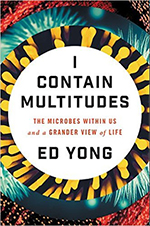 Ed Yong’s “Not Exactly Rocket Science” was one of the first science blogs that came onto my radar ten years ago when I was wading into geology blogging for the first time. He has an impressive record of excellent science journalism and really evocative writing. I was delighted to bump into him and introduce myself at the March for Science last winter. I hadn’t realized that he lived in DC nowadays. My wife (a biology teacher) really enjoyed his book I Contain Multitudes back when it was first released a few years ago, but I’ve only managed to get around to it just now. It’s great! I Contain Multitudes is about microbes, but it’s got a new, fresh slant on the topic: it’s about how microbial ecology is woven into every living thing, blurring the boundaries between “self” in a fundamental way. We used to think of our characteristics as some sort of essence (nature) mixed with the foibles of our individual histories (nurture), then switched to genes, and then we learned about epigenetic effects. But now we speak also of the microbiome, the sum total of the microbes (mostly bacteria) that live within us, and the chemical effluent that they release which alters the way we experience the world, the way we act, maybe even the way we think. We are used to thinking of inheritance in terms of genes, but Yong reveals that’s not the whole picture by a long shot. We also inherit microbes, and those microbes have genes. Some of those microbes are so thoroughly integrated into our cells as to be part of us (e.g., mitochondria), and some have merely left their genetic traces intermingled into the fabric of our own chromosomes. It’s a wild new way to look at living organisms – as communities that bear the vital endowments of all their ancestors, the imprint of all their histories. Top notch writing about top notch science: Recommended.
Ed Yong’s “Not Exactly Rocket Science” was one of the first science blogs that came onto my radar ten years ago when I was wading into geology blogging for the first time. He has an impressive record of excellent science journalism and really evocative writing. I was delighted to bump into him and introduce myself at the March for Science last winter. I hadn’t realized that he lived in DC nowadays. My wife (a biology teacher) really enjoyed his book I Contain Multitudes back when it was first released a few years ago, but I’ve only managed to get around to it just now. It’s great! I Contain Multitudes is about microbes, but it’s got a new, fresh slant on the topic: it’s about how microbial ecology is woven into every living thing, blurring the boundaries between “self” in a fundamental way. We used to think of our characteristics as some sort of essence (nature) mixed with the foibles of our individual histories (nurture), then switched to genes, and then we learned about epigenetic effects. But now we speak also of the microbiome, the sum total of the microbes (mostly bacteria) that live within us, and the chemical effluent that they release which alters the way we experience the world, the way we act, maybe even the way we think. We are used to thinking of inheritance in terms of genes, but Yong reveals that’s not the whole picture by a long shot. We also inherit microbes, and those microbes have genes. Some of those microbes are so thoroughly integrated into our cells as to be part of us (e.g., mitochondria), and some have merely left their genetic traces intermingled into the fabric of our own chromosomes. It’s a wild new way to look at living organisms – as communities that bear the vital endowments of all their ancestors, the imprint of all their histories. Top notch writing about top notch science: Recommended.
